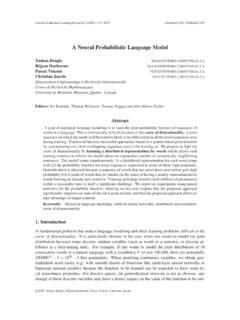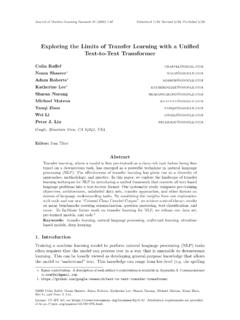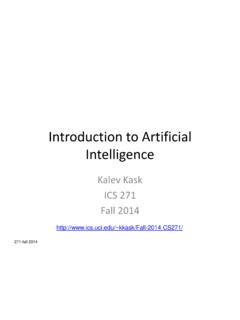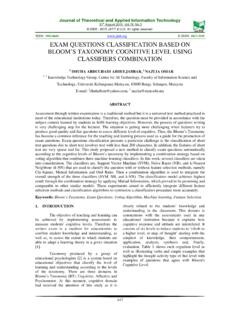Transcription of Natural Language Processing (Almost) from Scratch
1 Journal of Machine Learning Research 12 (2011) 2493-2537 Submitted 1/10; Revised 11/10; Published 8/11. Natural Language Processing (Almost) from Scratch Ronan Collobert RONAN @ COLLOBERT. COM. Jason Weston JWESTON @ GOOGLE . COM. Le on Bottou LEON @ BOTTOU . ORG. Michael Karlen MICHAEL . KARLEN @ GMAIL . COM. Koray Kavukcuoglu KORAY @ CS . NYU . EDU. Pavel Kuksa PKUKSA @ CS . RUTGERS . EDU. NEC Laboratories America 4 Independence Way Princeton, NJ 08540. Editor: Michael Collins Abstract We propose a unified neural network architecture and learning algorithm that can be applied to var- ious Natural Language Processing tasks including part-of-speech tagging, chunking, named entity recognition, and semantic role labeling. This versatility is achieved by trying to avoid task-specific engineering and therefore disregarding a lot of prior knowledge. Instead of exploiting man-made input features carefully optimized for each task, our system learns internal representations on the basis of vast amounts of mostly unlabeled training data.
2 This work is then used as a basis for building a freely available tagging system with good performance and minimal computational re- quirements. Keywords: Natural Language Processing , neural networks 1. Introduction Will a computer program ever be able to convert a piece of English text into a programmer friendly data structure that describes the meaning of the Natural Language text? Unfortunately, no consensus has emerged about the form or the existence of such a data structure. Until such fundamental Articial Intelligence problems are resolved, computer scientists must settle for the reduced objective of extracting simpler representations that describe limited aspects of the textual information. These simpler representations are often motivated by specific applications (for instance, bag- of-words variants for information retrieval), or by our belief that they capture something more gen- eral about Natural Language . They can describe syntactic information ( , part-of-speech tagging, chunking, and parsing) or semantic information ( , word-sense disambiguation, semantic role labeling, named entity extraction, and anaphora resolution).
3 Text corpora have been manually an- notated with such data structures in order to compare the performance of various systems. The availability of standard benchmarks has stimulated research in Natural Language Processing (NLP).. Ronan Collobert is now with the Idiap Research Institute, Switzerland.. Jason Weston is now with Google, New York, NY.. Le on Bottou is now with Microsoft, Redmond, WA.. Koray Kavukcuoglu is also with New York University, New York, NY.. Pavel Kuksa is also with Rutgers University, New Brunswick, NJ. c 2011 Ronan Collobert, Jason Weston, Le on Bottou, Michael Karlen, Koray Kavukcuoglu and Pavel Kuksa. C OLLOBERT, W ESTON , B OTTOU , K ARLEN , K AVUKCUOGLU AND K UKSA. and effective systems have been designed for all these tasks. Such systems are often viewed as software components for constructing real-world NLP solutions. The overwhelming majority of these state-of-the-art systems address their single benchmark task by applying linear statistical models to ad-hoc features.
4 In other words, the researchers them- selves discover intermediate representations by engineering task-specific features. These features are often derived from the output of preexisting systems, leading to complex runtime dependencies. This approach is effective because researchers leverage a large body of linguistic knowledge. On the other hand, there is a great temptation to optimize the performance of a system for a specific benchmark. Although such performance improvements can be very useful in practice, they teach us little about the means to progress toward the broader goals of Natural Language understanding and the elusive goals of Artificial Intelligence. In this contribution, we try to excel on multiple benchmarks while avoiding task-specific engi- neering. Instead we use a single learning system able to discover adequate internal representations. In fact we view the benchmarks as indirect measurements of the relevance of the internal represen- tations discovered by the learning procedure, and we posit that these intermediate representations are more general than any of the benchmarks.
5 Our desire to avoid task-specific engineered features prevented us from using a large body of linguistic knowledge. Instead we reach good performance levels in most of the tasks by transferring intermediate representations discovered on large unlabeled data sets. We call this approach almost from Scratch to emphasize the reduced (but still important). reliance on a priori NLP knowledge. The paper is organized as follows. Section 2 describes the benchmark tasks of interest. Sec- tion 3 describes the unified model and reports benchmark results obtained with supervised training. Section 4 leverages large unlabeled data sets ( 852 million words) to train the model on a Language modeling task. Performance improvements are then demonstrated by transferring the unsupervised internal representations into the supervised benchmark models. Section 5 investigates multitask supervised training. Section 6 then evaluates how much further improvement can be achieved by incorporating standard NLP task-specific engineering into our systems.
6 Drifting away from our ini- tial goals gives us the opportunity to construct an all-purpose tagger that is simultaneously accurate, practical, and fast. We then conclude with a short discussion section. 2. The Benchmark Tasks In this section, we briefly introduce four standard NLP tasks on which we will benchmark our architectures within this paper: Part-Of-Speech tagging (POS), chunking (CHUNK), Named Entity Recognition (NER) and Semantic Role Labeling (SRL). For each of them, we consider a standard experimental setup and give an overview of state-of-the-art systems on this setup. The experimental setups are summarized in Table 1, while state-of-the-art systems are reported in Table 2. Part-Of-Speech Tagging POS aims at labeling each word with a unique tag that indicates its syntactic role, for example, plural noun, adverb, .. A standard benchmark setup is described in detail by Toutanova et al. (2003). Sections 0 18 of Wall Street Journal (WSJ) data are used for training, while sections 19 21 are for validation and sections 22 24 for testing.
7 The best POS classifiers are based on classifiers trained on windows of text, which are then fed to a bidirectional decoding algorithm during inference. Features include preceding and following 2494. Natural L ANGUAGE P ROCESSING (A LMOST ) FROM S CRATCH. Task Benchmark Data set Training set Test set (#tokens) (#tokens) (#tags). POS Toutanova et al. (2003) WSJ sections 0 18 sections 22 24 ( 45 ). ( 912,344 ) ( 129,654 ). Chunking CoNLL 2000 WSJ sections 15 18 section 20 ( 42 ). ( 211,727 ) ( 47,377 ) (IOBES). NER CoNLL 2003 Reuters ( 17 ). ( 203,621 ) ( 46,435 ) (IOBES). SRL CoNLL 2005 WSJ sections 2 21 section 23 ( 186 ). ( 950,028 ) + 3 Brown sections (IOBES). ( 63,843 ). Table 1: Experimental setup: for each task, we report the standard benchmark we used, the data set it relates to, as well as training and test information. System Accuracy System F1. Shen et al. (2007) Shen and Sarkar (2005) Toutanova et al. (2003) Sha and Pereira (2003) Gime nez and Ma rquez (2004) Kudo and Matsumoto (2001) (a) POS (b) CHUNK.
8 System F1 System F1. Ando and Zhang (2005) Koomen et al. (2005) Florian et al. (2003) Pradhan et al. (2005) Kudo and Matsumoto (2001) Haghighi et al. (2005) (c) NER (d) SRL. Table 2: State-of-the-art systems on four NLP tasks. Performance is reported in per-word accuracy for POS, and F1 score for CHUNK, NER and SRL. Systems in bold will be referred as benchmark systems in the rest of the paper (see Section ). tag context as well as multiple words (bigrams, trigrams.. ) context, and handcrafted features to deal with unknown words. Toutanova et al. (2003), who use maximum entropy classifiers and inference in a bidirectional dependency network (Heckerman et al., 2001), reach per-word accuracy. Gime nez and Ma rquez (2004) proposed a SVM approach also trained on text windows, with bidirectional inference achieved with two Viterbi decoders (left-to-right and right-to-left). They obtained per-word accuracy. More recently, Shen et al. (2007) pushed the state-of-the-art up to , with a new learning algorithm they call guided learning, also for bidirectional sequence classification.
9 2495. C OLLOBERT, W ESTON , B OTTOU , K ARLEN , K AVUKCUOGLU AND K UKSA. Chunking Also called shallow parsing, chunking aims at labeling segments of a sentence with syntactic con- stituents such as noun or verb phrases (NP or VP). Each word is assigned only one unique tag, often encoded as a begin-chunk ( , B-NP) or inside-chunk tag ( , I-NP). Chunking is often evaluated using the CoNLL 2000 shared Sections 15 18 of WSJ data are used for training and section 20 for testing. Validation is achieved by splitting the training set. Kudoh and Matsumoto (2000) won the CoNLL 2000 challenge on chunking with a F1-score of Their system was based on Support Vector Machines (SVMs). Each SVM was trained in a pairwise classification manner, and fed with a window around the word of interest containing POS and words as features, as well as surrounding tags. They perform dynamic programming at test time. Later, they improved their results up to (Kudo and Matsumoto, 2001) using an ensemble of classifiers trained with different tagging conventions (see Section ).
10 Since then, a certain number of systems based on second-order random fields were reported (Sha and Pereira, 2003; McDonald et al., 2005; Sun et al., 2008), all reporting around F1. score. These systems use features composed of words, POS tags, and tags. More recently, Shen and Sarkar (2005) obtained using a voting classifier scheme, where each classifier is trained on different tag representations2 (IOB, IOE, .. ). They use POS features coming from an external tagger, as well carefully hand-crafted specialization features which again change the data representation by concatenating some (carefully chosen) chunk tags or some words with their POS representation. They then build trigrams over these features, which are finally passed through a Viterbi decoder a test time. Named Entity Recognition NER labels atomic elements in the sentence into categories such as PERSON or LOCATION . As in the chunking task, each word is assigned a tag prefixed by an indicator of the beginning or the inside of an entity.

















